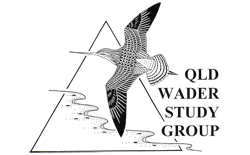Numenius minutus
Subspecies
None
Other Names
Little Whimbrel, Pigmy Curlew, Siberian Baby Curlew, Dough-bird.
Identification
Medium-sized wader with a large fine down-curved bill.
Plumage
Non-breeding: The crown and nape are dark brown. The back and sides of the neck are cream-buff streaked with brown. The upperparts are dark brown speckled are spotted with cream-buff. The chin and throat are white with fine streaks of brown. The breast and flanks are buff streaked with dark brown. The belly and vent are white. The long but fine bill is down-curved, black with a pink base. The legs are grey.
Breeding: Similar to the non-breeding plumage but there is more buff to the underparts and spotting on the upperparts is more buff giving a lighter look the the bird.
Juvenile: Similar to the non-breeding plumage but darker and less pronounced spots.
Distribution
Mainly found in northern Australia, fewer numbers of this species are found down the east and west coasts. The Little Curlew is usually found in areas of grassland, that can include pasture, airfields and playing fields. Rarely found in intertidal areas. Does prefer dry grassland and seems to move inland when the rains come.
Migratory habits
The Little Curlew arrives in northern Australia in late September with most birds arriving in October, then spreading south. It disperses to the inner grasslands as the rains come. It congregates in April and May ready to head to the breeding grounds. It migrates through China and Russia, not the coastal route of other waders.
Breeding
The Little Curlew breeds in Siberia from south of Taimyr across Yakutia to west central Chukotka.
Status
The estimated population is thought to be about 180,000 which is the same as the estimate for the East Asian-Australasian Flyway population.
Confusing Species
Whimbrel: This species is larger, 30% bigger, with a longer and thicker bill. Its plumage lacks that golden tinge that the Little Curlew has. It is bulkier and less upright.
Pacific Golden Plover: Very similar in posture and habits but does not have the long down-curved bill of the Little Curlew.
